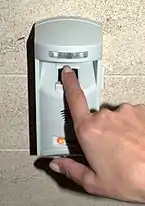Fingerprint scanner
Fingerprint scanners are security systems of biometrics. They are now used in police stations, security industries and recently, on smartphones.
Function
Everyone has patterns of friction ridges on their fingers, and it is this pattern that is called the fingerprint. Fingerprints are uniquely detailed, durable over an individual's lifetime, and difficult to alter. Because there are countless combinations, fingerprints have become an ideal means of identification.
Types of fingerprint scanners
There are four types of fingerprint scanner: the optical scanner, the capacitance scanner, the ultrasonic scanner, and the thermal scanner. The basic function of every type of scanner is to obtain an image of a person's fingerprint and find a match for it in its database. The measure of the fingerprint image quality is in dots per inch (DPI).[1]
- Optical scanners take a visual image of the fingerprint using a digital camera.
- Capacitive or CMOS scanners use capacitors and thus electrical current to form an image of the fingerprint. This type of scanner tends to excel in terms of precision.
- Ultrasound fingerprint scanners use high frequency sound waves to penetrate the epidermal (outer) layer of the skin.
- Thermal scanners sense the temperature differences on the contact surface, in between fingerprint ridges and valleys.
All fingerprint scanners are susceptible to be fooled by a technique that involves photographing fingerprints, processing the photographs using special software, and printing fingerprint replicas using a 3D printer.[2]
Construction forms

There are two construction forms: the stagnant and the moving fingerprint scanner.
- Stagnant: The finger must be dragged over the small scanning area. This is cheaper and less reliable than the moving form. Imaging can be less than ideal when the finger is not dragged over the scanning area at constant speed.
- Moving: The finger lies on the scanning area while the scanner runs underneath. Because the scanner moves at constant speed over the fingerprint, imaging is superior.
References
- Sadasivuni, Kishor Kumar; Houkan, Mohammad Talal; Taha, Mohammad Saleh; Cabibihan, John-John (August 2017). "Anti-spoofing device for biometric fingerprint scanners". 2017 IEEE International Conference on Mechatronics and Automation (ICMA). IEEE. doi:10.1109/icma.2017.8015898. ISBN 978-1-5090-6758-9. Archived from the original on 2021-01-17. Retrieved 2020-10-27.
- Winder, Davey. "Hackers Claim 'Any' Smartphone Fingerprint Lock Can Be Broken In 20 Minutes". Forbes. Archived from the original on 2019-12-19. Retrieved 2019-12-19.
